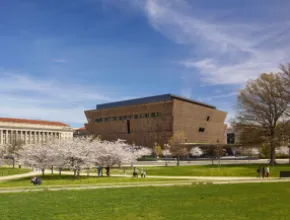In November 2017 the International Association of Exhibitions and Events (IAEE) brought Expo! Expo!, its annual meeting and exhibition, to San Antonio. The hosts put on quite the show for the “show for shows,” including re-creating the city’s annual Fiesta River Parade with decorated floats, music and local cuisine in the Henry B. Gonzalez Convention Center’s outdoor lagoon. When welcoming the National Travel Association’s annual Travel Exchange convention last year, the hospitality included greeting delegates at the preeminent The Witte Museum with mariachis, German choral singers and other sounds of San Antonio.
Alamo City has been honing the fine art of tradition since 1718. This tricentennial year has proven a banner occasion for event tie-ins, such as Spain: 500 Years of Spanish Painting from the Museums of Madrid at the event-capable San Antonio Museum of Art. Inaugurated by the King and Queen of Spain during their first official visit to San Antonio in June, the exhibition featured works by Picasso, El Greco and other Spanish masters never shown before in the U.S.
Centuries-old traditions are practiced here every day. San Antonio’s five historic missions, collectively a UNESCO World Heritage site, represent the largest concentration of Spanish colonial architecture in North America. Along with San Fernando Cathedral, the oldest church in Texas, all save The Alamo are still active Catholic parishes, with exceptional experiences that include the mariachi mass at Mission San Jose.
With groups seeking deeper immersion than ever in destinations and authentic experiences, San Antonio exemplifies the enduring power of Texas’ multi-layered heritage and tradition.
Hotel Headquarters
Texas Tourism’s latest hotel performance research report, released in March 2018, reveals a lodging sector keyed for growth. With some 475,630 rooms in 4,916 properties, room revenue reached $10.8 billion in 2017, up 8 percent from 2016.
Lodging Econometrics ranks Dallas and Houston second and third nationally for new hotel construction. According to a March 2018 report from leading real estate brokerage Marcus & Millichap, Texas is a pipeline leader with some 200 hotels adding nearly 23,800 rooms now under construction, and another 276 properties adding 31,300-plus rooms due to break ground in 2018.
Behind the numbers is a long tradition of hotel innovation. Modern-day entrepreneurs include the Houston-based Valencia Group. Offering group-capable properties such as the Hotel Valencia Riverwalk in San Antonio and Hotel Sorella in Houston, the company is expanding its retro-styled “motor court” concept with the new spaghetti western-themed Texican Court in Irving, opening in late 2018. With a trio of group-capable luxury boutique ZaZa hotels in Dallas and Houston, Dallas-based Z Resorts is expanding to Austin, slated for 2019.
Granddaddy of them all is Hilton Hotels & Resorts, launched by Conrad Hilton in 1925 with the 325-room Dallas Hilton. Today, Texas is landmarked with Hilton icons. El Paso’s Plaza Hotel, Hilton’s first high-rise property from 1930, will relaunch in 2019 following a $78 million transformation. Long a Dallas darling, the 1956 Statler Hilton reopened in October 2017 as the retro-styled, Hilton-flagged The Statler Dallas. The skybridge-connected Hilton Americas-Houston is a headquarters powerhouse.
Dating to 1979, the 27-story Hilton Anatole is another brand champion. Acquired by Hilton in 2005, this 1,606-room Dallas group magnet offers 600,000-plus square feet of versatile space, plus the programmable outdoor Jade Waters resort pool complex. Late owner-developer Trammell Crow filled the hotel with 1,000-plus pieces of global art, creating the largest hotel collection in the nation. With new Executive Chef Thomas Gray reinventing the menu, top-floor SER Steak + Spirits offers private dining rooms with stunning Dallas views.
Opened in 2014, the 299-room Hilton Dallas/Plano Granite Park is ideally equipped for Plano’s corporate-centric market. Flexibly hosting up to 1,000 delegates, the hotel’s 30,000-square-foot conference center includes two ballrooms and spacious prefunction area. Amenities include an outdoor resort-style pool and Italian-inspired Carso restaurant, with a bridge connection to the expanding waterfront dining options at The Boardwalk at Granite Park.
Gulf Coast groups have the 239-room Hilton Galveston Island Resort. Offering 15,000 square feet of flexible space, the property is on the campus of the 32-acre San Luis Resort Spa & Conference Center.
Home of the 140,000-square-foot Galveston Island Convention Center, this AAA Four Diamond beachfront destination offers 200,000 square feet of total space, 700 hotel rooms and 10 restaurants. The luxurious 250-room San Luis Resort includes private villas and the 40,000-square-foot IACC-accredited conference center with 22 soundproof meeting rooms.
Another award-winning Galveston group mainstay is Moody Gardens Hotel Spa & Convention Center. Covering 242 acres, this multi-venue complex offers 418 newly modernized luxurious rooms and 103,000 square feet of flexible convention space. Wide-ranging on-property attractions include the Sky Trail Ropes Course and recently renovated Aquarium Pyramid.
Originated by the Dunfey family of New England in 1958 with a 35-room motor lodge in New Hampshire, Omni Hotels & Resorts was purchased in 1996 by Corpus Christi, Texas-based TRT Holdings and relocated to Dallas. Since then, the company has invested significantly in Texas, including the long-sought 1,001-room Omni Dallas headquarter hotel, 614-room Omni Fort Worth and most recently, 300-room Omni Frisco. Other properties include the 392-room Omni Austin Hotel Downtown and Omni Barton Creek Resort & Spa in Texas Hill Country, slated to reopen in May 2019 as a 493-room resort following a $150 million transformation.
Omni also has deep ties to Texas history at San Antonio’s 338-room La Mansion del Rio. Offering 18,000-plus square feet of flexible space, this Spanish colonial-style hideaway on the River Walk dates to 1853 and celebrates its 50th anniversary as a hotel this year. The charm includes Las Canarias restaurant, a heated courtyard pool and access to Forbes Four-Star spa treatments at companion property Mokara Hotel & Spa.
PageBreakClaims to Fame
From pop culture to hurricane winds, legends and legacies have lasting marketing appeal.
It’s been 27 years since the original Dallas went off the air, but the prime-time soap opera about the feuding Ewing family, and its primary shooting location, Southfork Ranch, are as iconic as ever. As VisitDallas President and CEO Phillip Jones noted, the show “helped shape international perceptions of the city of Dallas.”
In March 2018, the bureau and venue partnered for a 40th anniversary commemoration of the show’s debut in 1978. Attended by Linda Gray, Patrick Duffy and other stars, the two-day event featured tours, live entertainment and a fan party in Southfork’s famed Longhorn Ballroom, filming location for many of the series’ bar scenes.
Planners can organize their own programs year-round. Set on 357 acres of groomed ranchland near Plano, “The World’s Most Famous Ranch” offers 63,000 square feet of flexible space for up to 10,000 attendees. Plus, there are Ewing Mansion property tours, trail rides, chuckwagon dinners and more.
While colorful myths often swirl around the origins of cocktails and other libations, VisitDallas has just staked claim as the “Official Home of the Frozen Margarita.”
In 1971, as the story goes, high school dropout turned Tex-Mex restaurateur Mariano Martinez, inspired by the Slurpee machine at his local 7-Eleven, co-engineered a soft-serve ice cream unit into the first frozen margarita machine. With the original device enshrined at the Smithsonian National Museum of American History, the bureau’s new free Margarita Mile app features 17 margarita stops in the city, including the original Mariano’s Hacienda (since expanded to five other locations) in North Dallas.
Presently investing in dynamic new multiuse visitor districts, Arlington has serious entertainment DNA in its past.
Billed as “Vegas before Vegas,” Top O’Hill Terrace famously combined a public restaurant and tea garden with a hidden gambling den and brothel. Raided by Texas Rangers in 1947, it became a Bible Baptist Seminary in 1956 and today serves as the home of Arlington Baptist University. Guided tours reveal the trap doors, escape tunnel and other features of this unique heirloom. Arlington is also famed as the birthplace of the Six Flags Over Texas theme park, in 1961.
In the late 1800s, Galveston Island boomed as the “Playground of the South,” a legacy perpetuated by attractions such as the Galveston Island Historic Pleasure Pier, and since 1867 the nation’s third-largest Mardi Gras celebration.
Hurricanes, most notably the devastating Great Storm of 1900, are another Galveston state of mind. The Galveston Historical Foundation’s interactive Galveston Flood attraction is scheduled to open next spring at the new $3.5 million multiuse Depot on Market development. The Texas Seaport Museum is undergoing a $2 million expansion that will include interactive exhibits focused on immigration from the 1830s through 1950s when Galveston, the “Ellis Island of the West,” served as the nation’s second-largest immigration port ever.
In 1901, engineer Anthony Lucas struck oil near Beaumont, birthing a signature Texas industry. The event is memorialized at the Spindletop-Gladys City Boomtown Museum, a re-created city complete with saloon, working blacksmith shops and replica oil gusher.
Frontier Finds
Inhabited for centuries by Native Americans, the far western tip of Texas was visited by successive Spanish expeditions starting around 1535. These explorers named the deep chasm between the area’s two double mountain ranges, “El Paso del Norte,” or the Pass of the North. Today, El Paso is a fast-expanding group destination offering a trove of discoveries for attendees.
The ancient past meets the present at downtown’s event-capable El Paso Museum of History, where “Digie” (Digital Information Gateway In El Paso) is a unique (one of only three in the world, and the only one in the U.S.) interactive touch-screen digital wall showcasing the region’s rich history. Groups can also explore the nine-mile El Paso Mission Trail, which includes San Elizario Chapel, established in 1789, and the 1682 Ysleta Mission, oldest mission in Texas.
Founded in 1881 as a railroad town, Abilene harnesses its Wild West past and colorful personality as the “Storybook Capital of Texas,” personified by a collection of outdoor public sculptures based on children’s literature. The city also leverages high tech to bring the past to life at event-capable Frontier Texas!, one of the few museums in the world featuring life-size holographic figures.
Lubbock showcases its Western heritage at the National Ranching Heritage Center, and the American Windmill Museum features the world’s largest collection of windmills.
PageBreakFestival express
In 1891, a group of women paraded past The Alamo in decorated horse-drawn carriages and pelted each other with flower blossoms. Honoring the heroes of The Alamo and San Jacinto, this inaugural Battle of Flowers Parade became the foundation of the city’s annual 10-day Fiesta San Antonio (www.fiesta-sa.org) celebration each April.
Largest of Fiesta’s multiple parades and second in size nationally behind the Tournament of Roses Parade in Pasadena, Calif., the Battle of Flowers is the only U.S. parade planned and directed exclusively by women, all volunteers. Featuring a royal court of two kings and seven queens, creative cuisine, live music and famed cascarones (colorful eggshells filled with confetti), Fiesta, attracting some 3.5 million visitors, commands San Antonio’s year-long festival season—and is one of many ready-made festival tie-ins for groups around the state.
Ideal for meetings and “Denim and Diamonds” galas, Fredericksburg’s Gillespie County Fairgrounds (www.gillespiefair.net) is home to the state’s oldest country fair, which celebrated its 130th anniversary this August.
Launched in 1980, September’s three-day Plano Balloon Festival (www.planoballoonfest.org) is the signature annual event of this fast-rising Metroplex city, featuring sky divers, fireworks, concerts and more. Abilene groups have the annual Big Country Balloon Fest (www.bigcountryballoonfest.org), also in September.
At the northern end of Mustang Island, stretching 18 miles from Corpus Christi, Port Aransas has swiftly rebounded from Hurricane Harvey. “Port A” hosts two signature annual Gulf events, both in April. Launched in 1997, Texas SandFest (www.texassandfest.org), attracting a record 100,000-plus attendees in 2018, is the “Largest Native-Sand Sand Sculpture Competition” in the U.S. Dating to 1932, the Deep Sea Roundup (www.deepsearoundup.com) is the state’s oldest fishing competition. In November 2018, Port A inaugurates a new tradition: hosting the Texas state qualifiers for the World Food Championships (https://worldfoodchampionships.com).
Houston’s hugely popular annual Art Car Parade (www.thehoustonartcarparade.com) each April is a must-see showcase of the city’s inventive, often zany creative spirit.
Year-end traditions include 1,400 Christmas events over 40 days in Grapevine, the “Christmas Capital of Texas” (www.grapevinetexasusa.com/christmas-capital-of-texas), and Christmas in The Woodlands (http://woodlandsevents.com/winter).
–Jeff Heilman
All aboard!
Scheduled to launch in late 2018, TEXRail (www.texrail.com) will introduce a new era of convenience for Metroplex visitors and groups. Linking downtown Fort Worth with DFW International Airport’s Terminal B, the $1 billion, 27-mile commuter line advances a historic tradition of transformative rail projects in the region.
The project includes Grapevine Main (www.grapevinetexasusa.com), a $105 million development incorporating a new multi-level train station with event space, 21-room Autograph Collection by Marriott hotel and 38,000-square-foot outdoor event plaza.
Scheduled for late 2019, the project has a historic antecedent dating back over a century. With the first tracks laid in Grapevine, then the farming community of Grape Vine Prairie, around 1888, the St. Louis Southwestern Railway arrived in 1891. Running through Grapevine to the Fort Worth Stockyards, that route, best known as the Cotton Belt, operates today as the Grapevine Vintage Railroad. Available for tours, charters and private events, groups ride in authentic Victorian-era coaches pulled by 1896 steam engine Puffy (out until 2019 after repairs) or 1953 diesel locomotive Vinny.
In 1903, J.O. Schulze and Otis Brown of the Chicago, Rock Island and Gulf Railway were surveying land between Dallas and Fort Worth for a new railroad. Deciding on a small circa-1857 farming settlement, they purchased 80 acres and named it Irving. Today, this Metroplex gateway is a Fortune 500 hotbed with 75-plus hotels and state-of-the-art convention and entertainment campus. Groups can discover the city’s railroad origins and more in the Irving Heritage District (www.irvingtexas.com), featuring historic structures in Heritage Park and 1940s-era Big State Fountain Grill.
The railroads also created Frisco. Originally Lebanon, this 1850s-era settlement was a watering stop for the St. Louis-San Francisco Railway around 1902. In 1904, residents renamed their town Frisco City, later shortened to Frisco. The history of North Texas railroads and more is presented at Frisco’s Museum of the American Railroad (www.museumoftheamericanrailroad.org), recently relocated from Dallas and offering group tours and event hosting.
Plano’s Interurban Railway Museum (www.interurbanrailwaymuseum.org) features a historic Texas Electric Railway railroad car that once ran from Denison to Waco.
In Fort Worth, Ashton Depot (http://theashtondepot.com) is a full-service event venue housed in the landmark former 1899 Santa Fe Depot.
Outside of the Metroplex, San Antonio’s Sunset Station (www.sunset-station.com) revived a restored rail complex from 1902, while Lubbock’s Entertainment District (www.visitlubbock.org/depot-entertainment-district) was formerly a train depot.
–Jeff Heilman







